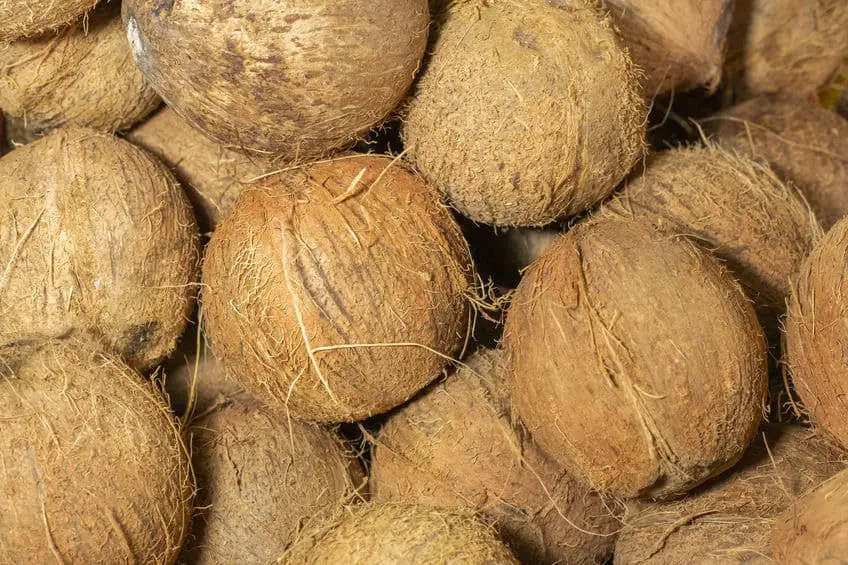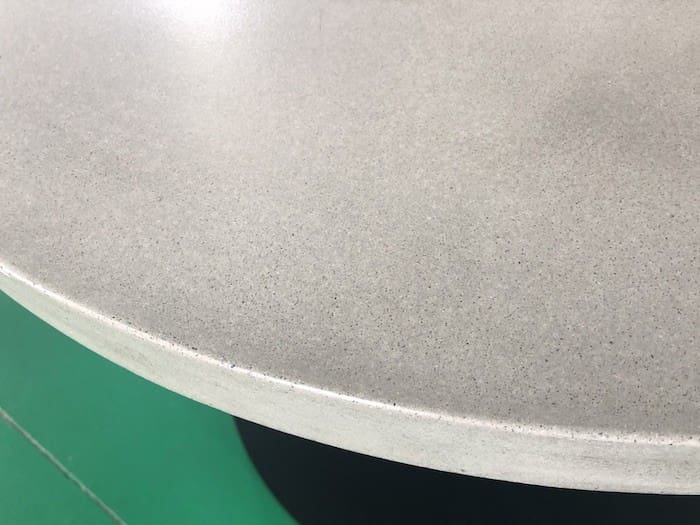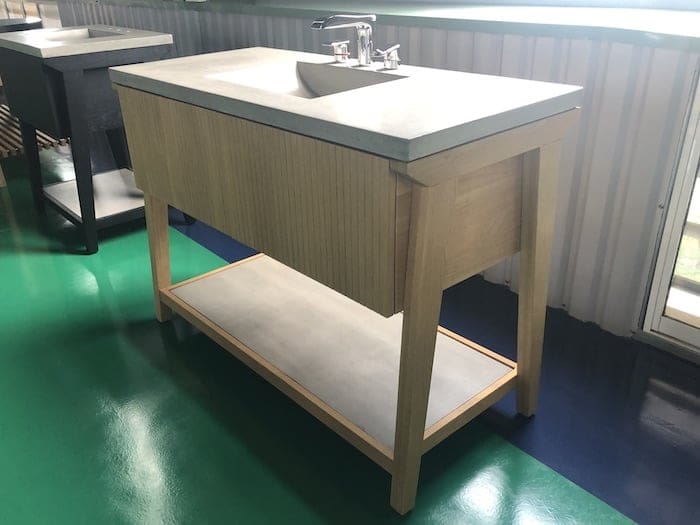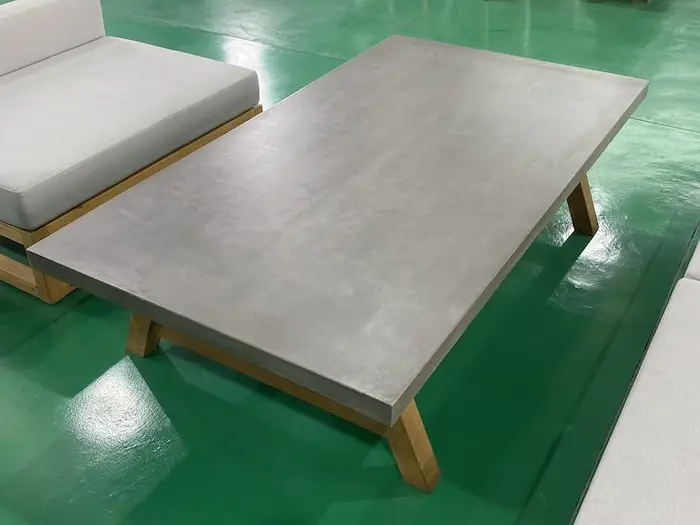One of our new favorite materials is the outdoor lightweight concrete. We find this to be a nice and versatile material.
The lightweight outdoor concrete is mixed using cement and coconut fiber dust. The coconut coir dust is a natural material made from coconut shells. As coconut shells are usually agricultural waste, they are considered an upcycled material. The lightweight concrete has strength and toughness and is relatively crack-free so it can be used in various home decor and furniture products.
Table of Contents
- Cement and Coconut Fiber
- Coconut Coir Dust
- Lightweight Concrete Information
- Home Products to Develop Using Lightweight Concrete
- Related Questions
This cement and coconut fiber dust is a material that continues to gain popularity. Here are many of the reasons why we are so fascinated by this new material.

Cement and Coconut Fiber
Lightweight concrete or cement is a great addition to the home decor and home furniture product category. This new material is a combination of coconut coir dust and cement.
The Shell of the Coconut
One of the main ingredients for this lightweight concrete is coconut coir dust. Coconut coir dust is a natural material that has a variety of uses.
We planted a rooftop vegetable garden in Hanoi, Vietnam the other day. One of the materials we purchased to mix with some soil was coconut coir dust.
The name coir comes from the Indian Malayalam word that means cord. This material has been used for centuries on products such as floor mats, doormats, mattresses, brushes, and cords. It is also used to make strings, ropes, and fishing nets. In the second half of the 19th century, it was used in England to make carpets and other floor coverings.
It is known to be a versatile material. Rope made from coconut coir fiber does not sink, so when it is used in the shipping industry the weight of the ropes made from coconut coir fiber will not weigh down or drag down the boats or buoys in the water.
Coconut Coir Dust
The kind of coconut coir we use is called coconut coir dust. Coconut coir dust is also known as cocopeat, coir waste, or fiber dust. This is such an excellent material for crops because it will retain water firmly and release water to the plants over time to allow them to grow.
In many parts of the world, coconut core dust is said to help fortify crops against drought because the properties of coconut coir dust allow it to hold water in the soil.
Due to its natural properties, coconut coir fiber is known to be relatively waterproof. It is also one of the few natural fibers resistant to any damage due to saltwater.
The coconut coir fiber and coconut coir dust are all made from the outer shells of the coconut. For the coconut coir dust, the outer part of the coconut shell is ground into a fine dust powder. For the coconut coir fiber, longer strands of the coconut are left.
Coconut coir dust generally comes in two colors: white and brown.

Coconut Coir Dust – An Upcycled Product
The husk of the coconut has long been considered an agricultural waste product. The coconuts are grown for the fruit of the coconut or to extract coconut oil.
Though the coconut coir fiber and coconut coir dust were used to make various products, the shell was considered a waste product for most of the agricultural production of coconuts. It was not uncommon for it to be dumped as agricultural waste.
We call coconut coir dust and coconut coir fiber an upcycled product. Upcycled is defined as:
“reuse (discarded objects or material) in such a way as to create a product of higher quality or value than the original.”
Oxford dictionary
Since the shell of the coconut has long been considered a discarded agricultural waste product, mixing the coconut coir dust with cement and other materials is a new way to use this waste.
This came about because scientists and others have been looking at coconut coir dust and coconut coir fiber as a material used in construction. They have been looking for materials to help defray the cost of building for many of the world’s population. One of the fibers they have tested extensively is the cement and coconut coir mixture, now known as lightweight concrete.

Lightweight Concrete Information
This invention of lightweight concrete made from coconut coir dust and cement is perfect for all kinds of outdoor furniture and home decor products. Here are some of the properties of this natural fiber with cement:
- Compression Strength – Though the compressive strength of the concrete decreased some with the natural fibers, the compression strength is still very good for construction purposes. It is considered very good for home decor and outdoor furniture manufacturing.
- Toughness – The coconut coir fibers and dust will add some overall toughness to the concrete mixture.
- Crack-free – The natural fibers in the concrete also mean fewer cracks. They found this to be an excellent alternative to a traditional cement mixture in that there is much less cracking with lightweight concrete.
This means that lightweight concrete or the coconut coir dust and cement mixture is an excellent choice for home decor products and outdoor and indoor furniture.

Home Products to Develop Using Lightweight Concrete
There are a lot of attractive home decor and home furniture products that you can consider developing using lightweight concrete.
Here are some of our top choices:
- Outdoor table tops – One of the significant ways that outdoor concrete is used in home decor and home furniture is with outdoor table tops. Combining the lightweight concrete with teak wood is the best way to use this for the outdoor space. Metal is also another good alternative.
- Indoor and Outdoor sinks and countertops – As more people have outdoor spaces, outdoor concrete is now being used to produce sinks that can be used indoors or in outdoor spaces.
- Accent tables and furniture – Lightweight concrete can be used for all kinds of accent tables and furniture for indoor and outdoor spaces.
- Benches – We have seen some nice outdoor benches made of lightweight concrete.
- Accessory items – There are many kinds of accessory items and decorative elements that can use lightweight concrete. This is the perfect kind of material to mold into a variety of shapes and sizes.
We love this material since it has an excellent eco story with the use of coconut coir dust and many great inherent qualities that make it a perfect choice for outdoor and indoor home furniture and home decor products.
If you want to learn more about lightweight concrete furniture production and manufacturing, please get in touch with us through our contact page or leave us a comment. We are happy to discuss this fantastic product and manufacturing material.
If you are interested in seeing how Mondoro can be a valuable partner for your home decor and home furnishing products – we would love to talk to you to see how we can help you.
Find out more about how Mondoro can help you create, develop, and manufacture excellent home decor and home furniture products – don’t hesitate to contact me, Anita. Check out my email by clicking here or become a part of our community and join our newsletter by clicking here.
Mondoro gives out a FREE Lookbook to anyone interested. You can receive a copy of our latest Lookbook by clicking here.
Listen to our Podcast called Global Trade Gal. You can find it on all major podcast platforms. Try out to listen to one of our podcasts by clicking here.
Subscribe to our Mondoro Company Limited YouTube Channel filled with great videos and information by clicking here.
Related Questions
Where is the Lightweight Concrete Manufactured?
We manufacture our outdoor lightweight concrete in Vietnam. There are many reasons we do it there, but one of the reasons is that Vietnam does well in this kind of manufacturing, and they have the technical skills, along with the supply of the coconut coir dust to manufacture this kind of lightweight concrete.
Another reason is the tariffs that countries like the United States have placed on China; Vietnam is one country that has become a clear winner in this trade war. One of the reasons is that Vietnam has a relatively large, young, educated, and skilled population and workforce. The Vietnamese Government also has a business-friendly attitude, and the country continues to develop many excellent shipping ports.
You can read our blog about manufacturing your products in Vietnam called 8 Reasons to Look Towards Manufacturing Your Products in Vietnam by clicking here.
What Other Outdoor Furniture Can You Manufacture?
We also manufacture in teak, solid wood, metal, and woven faux rattan. All of these items are also manufactured in Vietnam. Vietnam has a wonderful outdoor manufacturing industry. It offers a lot of great products and high-level skillsets for the outdoor furniture industry.
If you want to learn more about furniture faux rattan production and manufacturing, you can read our blog on Hand-weaving Faux Rattan In Vietnam, What You Need to Know by clicking here. The blog also has a link to our Youtube video that shows some of the Vietnamese faux rattan handweavers. You can see how highly skilled they are at hand weaving.


